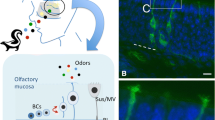Abstract
Many patients with olfactory dysfunction not only experience quantitative reduction of olfactory function, but also suffer from distorted olfactory sensations. This qualitative dysfunction is referred to as parosmia (also called “troposmia”) or phantosmia, with the major difference that distorted olfactory sensations are experienced in the presence or absence of an odor, respectively. Our clinical observations corroborate the literature in terms of a general underestimation of the incidence of olfactory distortions. Based on selected cases we try to show that olfactory distortions exhibit a large variance in their clinical appearance. Further, emphasis is placed on the fact that only a detailed and directed history of the patient can provide cues to the correct diagnosis.
Similar content being viewed by others
References
Axel R (1995) The molecular logic of smell. Sci Am Oct:130–137
Cain WS, Gent JF, Goodspeed RB, Leonard G (1988) Evaluation of olfactory dysfunction in the Connecticut Chemosensory Clinical Research Center (CCCRC). Laryngoscope 98:83–88
Deems DA, Doty RL, Settle RG, Moore-Gillon V, Shaman P, Mester AF, Kimmelman CP, Brightman VJ, Snow JBJ (1991) Smell and taste disorders: a study of 750 patients from the University of Pennsylvania Smell and Taste Center. Arch Otorhinolaryngol HNS 117:519–528
Doty RL, Shaman P, Dann M (1984) Development of the University of Pennsylvania Smell Identification Test: A standardized microencapsulated test of olfactory function (UPSIT). Physiol Behav 32:489–502
Duncan HJ, Seiden AM (1995) Long-term follow-up of olfactory loss secondary to head trauma and upper respiratory tract infection. Arch Otolaryngol HNS 121:1183–1187
Faulcon P, Portier F, Biacabe B, Bonfils P (1999) Anosmie secondaire à une rhinite aiguë: sémiologie et évolution à propos d’une série de 118 patients. Ann Otolaryngol Chir Cervicofac 116:351–357
Hummel T, Kobal G (2001) Olfactory event-related potentials. In: Simon SA, Nicolelis MAL (eds) Methods and frontiers in chemosensory research. CRC Press, Boca Raton, pp 429–464
Hummel T, Sekinger B, Wolf SR, Pauli E, Kobal G (1997) “Sniffin’ sticks”: olfactory performance assessed by the combined testing of odor identification, odor discrimination and olfactory threshold. Chem Senses 22:39–52
Hummel T, Heilmann S, Hüttenbrink KB (2002) Lipoic acid in the treatment of smell dysfunction following viral infection of the upper respiratory tract. Laryngoscope 112:2076–2080
Kobal G, Klimek L, Wolfensberger M, Gudziol H, Temmel A, Owen CM, Seeber H, Pauli E, Hummel T (2000) Multicenter investigation of 1,036 subjects using a standardized method for the assessment of olfactory function combining tests of odor identification, odor discrimination, and olfactory thresholds. Eur Arch Otorhinolaryngol 257:205–211
Lämmle H (1931) Über Geruchsstörungen und ihre klinische Bedeutung. Arch Ohr Nas Kehlk Heilk 130:22–42
Leopold D (1995) Distorted olfactory perception. In: Doty RL (eds) Handbook of olfaction and gustation. Marcel Dekker, New York, pp 441–454
Leopold D (2002) Distortion of olfactory perception: diagnosis and treatment. Chem Senses 27:611–615
Leopold DA, Schwob JE, Youngentob SL, Hornung DE, Wright HN, Mozell MM (1991) Successful treatment of phantosmia with preservation of olfaction. Arch Otolaryngol HNS 117:1402–1406
Leopold DA, Loehrl TA, Schwob JE (2002) Long-term follow-up of surgically treated phantosmia. Arch Otolaryngol HNS 128:642–647
Miwa T, Furukawa M, Tsukatani T, Costanzo RM, DiNardo LJ, Reiter ER (2001) Impact of olfactory impairment on quality of life and disability. Arch Otolaryngol HNS 127:497–503
Mueller C, Kallert S, Renner B, Stiassny K, Temmel AF, Hummel T, Kobal G (2003) Quantitative assessment of gustatory function in a clinical context using impregnated “taste strips.” Rhinology 41:2–6
Nordin S, Murphy C, Davidson TM, Quinonez C, Jalowayski AA, Ellison DW (1996) Prevalence and assessment of qualitative olfactory dysfunction in different age groups. Laryngoscope 106:739–744
Pryse-Phillips W (1971) An olfactory reference syndrome. Acta Psychiatr Scand 47:484–509
Quint C, Temmel AF, Schickinger B, Pabinger S, Ramberger P, Hummel T (2001) Patterns of non-conductive olfactory disorders in eastern Austria: a study of 120 patients from the Department of Otorhinolaryngology at the University of Vienna. Wien Klin Wochr 113:52–57
Stevens JC, Cain WS (1986) Smelling via the mouth: effect of aging. Percept Psychophys 40:142–146
Straschill M, Stahl H, Gorkisch K (1983) Effects of electrical stimulation of the human olfactory mucosa. Appl Neurophysiol 46:286–289
Tanaka O, Mukaino Y (1999) The effect of auricular acupuncture on olfactory acuity. Am J Chin Med 27:19–24
Temmel AF, Quint C, Schickinger-Fischer B, Klimek L, Stoller E, Hummel T (2002) Characteristics of olfactory disorders in relation to major causes of olfactory loss. Arch Otolaryngol Head Neck Surg 128:635–641
Wolfensberger M, Hummel T (2002) Anti-inflammatory and surgical therapy of olfactory disorders related to sino-nasal disease. Chem Senses 27:617–622
Wolfensberger M, Schnieper I, Welge-Lussen A (2000) Sniffin’Sticks: a new olfactory test battery. Acta Otolaryngol 120:303–306
Wysocki CJ, Gilbert AN (1989) National Geographic Smell Survey: effects of age are heterogenous. Ann NY Acad Sci 561:12–28
Zarinko K (1896) Über Kakosmia subjectiva. In: Festschrift zur Feier des 80-jährigen Stiftungsfestes des ärztlichen Vereins zu Hamburg. Langkammer, Leipzig, pp 339–342
Zilstorff K (1966) Parosmia. J Laryngol 80:1102–1104
Acknowledgements
This work was supported by a grant from the Swiss National Fund for Scientific Research FNSRS (no. 3100A0-100621-1) to JSL, and a grant from the Deutsche Forschungsgemeinschaft (DFG HU441/2-1) to TH.
Author information
Authors and Affiliations
Corresponding author
Rights and permissions
About this article
Cite this article
Frasnelli, J., Landis, B.N., Heilmann, S. et al. Clinical presentation of qualitative olfactory dysfunction. Eur Arch Otorhinolaryngol 261, 411–415 (2004). https://doi.org/10.1007/s00405-003-0703-y
Received:
Accepted:
Published:
Issue Date:
DOI: https://doi.org/10.1007/s00405-003-0703-y




